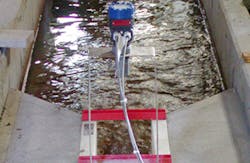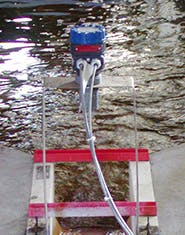The U.S. Federal Communications Commission (FCC) has adopted rules that are geared specifically to level probing radars (LPRs) that allow these devices to operate anywhere in the country without a license. The Measurement, Control & Automation Association (MCAA) worked with the FCC to provide information to the technical office within the FCC, which crafted a Notice of Proposed Rulemaking in 2012. The FCC action amends the existing rules to account for LPR special technical characteristics, which posed previous obstacles to FCC approval.
“Previously, the methodology for measuring radio-frequency emissions made it virtually impossible for LPRs to meet the requirements unless they were contained (primarily used in tanks),” says Cynthia Esher, president of MCAA. “The new rules allow LPRs to be used in the U.S., virtually anywhere, in a number of frequency bands.”
“Prior to this new ruling, level probing radars had to be licensed as low-power devices per the rules in FCC Part 15.209,” says John Benway, engineering manager for Magnetrol International. “The low power requirements restricted level probing radars to applications inside tanks.”
However, Benway says end-users are increasingly interested in using the technology outside tanks. A typical application is flow in the water & wastewater industry. The level in a specially designed constriction of a flume or weir can be related to flow. These measurements are made outside. The technology generally used today is ultrasonic, which can be susceptible to environmental conditions, such as temperature, wind, and humidity, none of which are an issue for radar technology.
READ ALSO: FCC Revises Rules Regulating Frequency Bands for Radar Level Measurement Devices
Specifically, the order modifies Part 15 of the FCC rules for level probing radars to operate on an unlicensed basis in the 5.925-7.250 GHz, 24.05-29.00 GHz, and 75-85 GHZ bands, and revises the measurement procedures to provide more accurate and repeatable measurement protocols for these devices.
“Customers increasingly requested these products, which are available in other parts of the world,” said Esher. “Obtaining individual waivers to sell in specific applications or in individual frequency bands was very difficult and time consuming, which limited the ability of manufacturers to meet the needs of their customers.”
The basis for this ruling was brought to attention of the MCAA staff and Board of Directors in 2009, and several companies decided to work together on the project, reviewing the existing FCC rules for level probing radar equipment.
Once funding for the project was received, the group began developing a proposal for workable rules, which included procedures for testing devices for compliance. MCAA’s memorandum on the issue was submitted to the FCC in early 2011.
It took over a year for the FCC Notice of Proposed Rulemaking to be issued as they allowed for comments and responses from the public. The new rules were published in January of this year.
The initial press release on the ruling noted that “special technical characteristics” posed previous obstacles to FCC approval. Esher touched on this by saying, “The previous FCC rules for unlicensed devices, including radars, required low transmitter power and a relatively uniform signal that lacks extreme peaks of energy. An LPR signal is inherently “peaky” and, for that reason, did not comply. Moreover, the permitted transmitter power was inadequate for many LPR applications.”
The new rules are designed to take these issues into account in permitting usefully high transmitter power, while avoiding significantly increasing the risk of interference to other spectrum users.
“The ruling harmonizes the requirements with European standards,” says Benway. “The sister organization to the MCAA, the Canadian Process Control Association (CPCA), is working with Industry Canada to have the Canadian rules harmonized.”
Harmonization of the standards in the U.S., Canada, and Europe means manufacturers can now supply a single product that can be sold in each of these regions. The ruling also standardizes and harmonizes the testing methods. These are major benefits for suppliers, says Benway.
The order from the FCC mentions MCAA’s request that the agency continue to provide an option to certify LPRs under the general emission limits of Section 15.209. FCC also agreed to continue to allow LPRs to operate in any frequency range that does not contain a restricted band, as permitted by Section 15.209, since some LPRs need bandwidths wider than the new rules permit to achieve precision measurements.
While members would have liked to include other frequency bands, Esher says “The new rules will allow the majority of manufacturers to provide LPR instrumentation to customers for use in a wide range of applications without licensing from the FCC.”
Jake Mastroianni is the managing editor of Flow Control magazine and www.FlowControlNetwork.com. He can be reached at [email protected]. Follow Jake on Google+.



